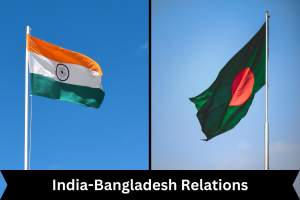
The arrest of Chinmoy Krishna Das, a Vaishnavite leader and one-time member of the International Society for Krishna Consciousness (ISKCON) in Bangladesh, by the Dhaka Metropolitan Police has prompted protests demanding his release in Dhaka’s Shahbag neighbourhood and Chittagong. The arrest has added to the further slump in India-Bangladesh relations following the attack on minorities in the after math of fall of Sheikh Hasina’s government. India and Bangladesh Relations.
| Reasons Behind Sheikh Hasina’s Exit 1. Peaceful Student demonstration evolving into a nationwide movement- The peaceful student protest against the freedom fighter reservation of 30% in civil services, galvanized into a nationwide movement due to Government’s heavy-handed approach. The attack on students by Awami League’s student wing, Bangladesh Chhatra League, imposition of a strict curfew with a ‘shoot-on-sight’ order and labelling the demonstrators as ‘Razakars'(a term associated with collaborators during the 1971 war) further inflamed tensions. 2. Slowing down of economic Growth- Bangladesh made rapid economic progress under Sheikh Hasina’s regime. The country’s per capita income tripled in a decade, with the World Bank estimating that over 25 million people were lifted out of poverty in the last 20 years. However, the pandemic in 2020 and a slowing global economy, thereafter, hit the garment industry badly. This increased unemployment, inflation in the economy and discontent of Bangladeshi Population. 3. Eroding democratic values- The Parliamentary elections in 2014, 2018, and 2024 were controversial and non-participative as they were marred by low turnout, violence, and boycotts by opposition parties. 4. Reliance on Hard Power to maintain Control- Hasina’s government increasingly relied on hard power to maintain control. This created a climate of fear and repression. For ex- The Digital Security Act 2018, became a potent weapon for the government and ruling party activists to silence critics and stifle freedom of online expression. 5. Increasing economic inequality- The proliferation of Bank scams and an expanding list of defaulters, coupled with rampant corruption, fuelled public discontent despite the overall economic progress. For ex– Companies like CLC Power, Western Marine Shipyard, and Remex Footwear topped the list of defaulters, with bad loans ranging from 965 crore to 1,649 crore Bangladeshi Taka. |
What challenges has the exit of Sheikh Hasina created in the India-Bangladesh Relations?
1. Attacks on minorities across both the borders- The ethnic attacks on Bangla-speaking Hindus in Bangladesh and the attacks on Bangladeshi’s in India have strained the India-Bangladesh relations.
2. Resurfacing of security challenges- The are risks of emergence of security challenges by the anti-India groups as encountered during the earlier BNP-Jamaat years. With the continuing tensions on the border with Pakistan, Indian Army’s long standoff with the PLA in eastern Ladakh, has created a security-nightmare for India.
3. Threat to India’s connectivity with the North-east- A further deterioration in Indo-Bangladesh has restricted India’s access to the Northeast. This region’s connection to mainland India will only remain through the narrow “Chicken’s Neck”. With the Myanmar border remaining extremely volatile, the source of unrest in India’s Northeast will increase.
4. Jeopardized the Bilateral trade and FTA- Sheikh Hasina’s exit has jeopardized the growing bilateral trade ties between India and Bangladesh. There has also been stagnation of talks in the potential free trade agreement (FTA) between the two countries.
5. Deterioration of people-people ties- There are real risk of blowback from the Bangladeshi people and the new power centres in Dhaka- some of whom will carry past grudges against India.
6. Geopolitical challenges- Pakistan and China will see the political change in Bangladesh as an opportunity to challenge India’s presence in the country and try to tar it with a pro-Hasina brush.
What are the other Challenges in India-Bangladesh Relations?
1. Sharing of Transboundary River Waters- India and Bangladesh share 54 common rivers, but only two transboundary river water sharing treaties have been signed, so far- Ganga Waters Treaty and The Kushiyara River Treaty. For Ex- Major point of contention is the Teesta river water dispute. Bangladesh seeks equitable distribution of Teesta waters, which has not been agreed by India and its state of West Bengal.
2. Deportation of Rohingyas- India and Bangladesh have mutual but conflicting interests in deportation of Rohingyas to mainland Myanmar. India seeks to give primacy to deportation from its mainland first and then later facilitate deportation from Bangladesh to Myanmar.
3. Cross-Border terrorism and infiltration- Cross-border terrorism and infiltration through the Bangladesh border have raised additional threats to internal security of India. Armed Dacoity in border districts, fake money transfer, cattle smuggling and prostitution have also raised internal security concerns in India.
4. Drug Smuggling & Trafficking- According to 2007 International Narcotics Control Board (INCB) report, the drugs trafficking through India from Bangladesh, remains a prime transit point of trafficking heroin from South Asia to Europe.
5. Growing Chinese Influence in Bangladesh– Bangladesh is an active partner in the Belt and Road Initiative (BRI). China has made substantial investments in Bangladeshi infrastructure by building 12 highways, 21 bridges and 27 power and energy projects. China’s increasing involvement with Bangladesh potentially undermines India’s regional standing and impede its strategic aspirations.
What is the significance of Bangladesh for India?
1. Geo-strategic- Bangladesh holds significant geostrategic importance for India as India’s eastern neighbour. Bangladesh provides India with access to the Bay of Bengal and an important route for trade and connectivity with Southeast Asia.
2. Geo-political- A stable and friendly Bangladesh is crucial for India’s security. Geo-political cooperation on issues such as counter-terrorism and border security is vital for maintaining peace in the South Asian region. Support of Bangladesh is crucial in India’s bid for UNSC permanent membership.
3. Economic- Bangladesh is a critical economy for India’s exports and bilateral trade. Deepening of India- Bangladesh economic relationship is crucial for India achieving its goal under the new foreign trade policy and of becoming a $5 trillion economy.
4. Cultural and civilisational- Bangladesh has large number of Hindu Bengali population and has large number of religious-cultural sites associated with India such as Ranir Bunglow Temple, Bhoj Vihara.
5. International cooperation- Active cooperation between India and Bangladesh is crucial to success of regional forums such as the BIMSTEC (Bay of Bengal Initiative for Multi-Sectoral Technical and Economic Cooperation), SAARC (South Asian Association for Regional Cooperation) and COPs to UNFCCC.
How did India- Bangladesh Relations prosper Under Sheikh Hasina’s Regime?
Sheikh Hasina’s tenure has fostered a healthy relationship between New Delhi and Dhaka. The India- Bangladesh relations deepened during her 15 years in power.
1. Eradication of anti-India Terror Groups- The anti-India terror groups and their benefactor, the Jamaat-e-Islami Bangladesh, which operated out of safe havens in Bangladesh during the BNP-Jamaat rule in 2001-06 were eradicated after Sheikh Hasina’s return to power.
2. Increase in Bilateral Trade- India-Bangladesh bilateral trade relations deepened during Sheikh Hasina’s regime. India-Bangladesh bilateral trade in FY 2023–24 amounts to $13 billion, with Bangladesh being India’s biggest trade partner in the subcontinent, and India being Bangladesh’s second-biggest partner in Asia after China. India provided duty-free quota access to Bangladesh on all tariff lines, except tobacco and alcohol, under South Asian Free Trade Area (SAFTA) since 2011.
3. Increased Connectivity projects- India and Bangladesh developed a slew of infrastructure and connectivity projects during the Sheikh Hasina’s regime. Some of the completed ones are-
a. Inaguration of the Akhaura-Agartala cross-border rail link and Khulna-Mongla Port rail line in November 2023.
b. Five operational bus routes between India and Bangladesh, including connections from Kolkata, Agartala and Guwahati to Dhaka.
c. Agreement for the usage of the Chittagong and Mongla ports to ease the movement of cargo between mainland India and the Northeast.
d. India’s extension of three lines of credit to Bangladesh since 2016 amounting to $8 billion for the development of road, rail, shipping and port infrastructure.
4. Discussions on FTA- India and Bangladesh had begun negotiations for a free trade agreement which would be beneficial for both the countries under Sheikh Hasina’s regime. An FTA would reduce or eliminate customs duties on goods traded between India and Bangladesh, and ease norms to help promote further trade and investments.
5. Land Boundary Agreement (2015)- India and Bangladesh swapped the disputed islands and allowed the inhabitants to choose their country of residence. This solved a major long-standing dispute between India and Bangladesh.
6. Energy cooperation- The energy cooperation between India and Bangladesh deepened during Sheikh Hasina’s regime. Bangladesh nearly imports 2,000 megawatts of electricity from India. The India-Bangladesh Friendship Pipeline, connecting Siliguri in West Bengal and Parbatipur in Bangladesh, will transport one million Metric Tonnes Per Annum (MMTPA) of High-Speed Diesel to Bangladesh.
7. Defence Cooperation- India- Bangladesh border of 4096.7 km is the longest land boundary that India shares with any of its neighbours. India and Bangladesh conduct Joint Exercises like Exercise Sampriti (Army) and Exercise Bongosagar (Navy).
8. Tourism sector- Bangladeshis make up a large portion of tourists in India. In 2017, the number of tourists from Bangladesh outnumbered all the tourists arriving from Western Europe.
9. Medical Cooperation- Bangladesh accounts for more than 35% of India’s international medical patients and contributes to more than 50% of India’s revenue from medical tourism.
What Should be India’s approach to deal with the Bangladesh Crisis?
1. Raising the attacks on Minorities- India must raise its concerns on the attacks on Hindu minorities by raising it bilaterally and multilaterally through UN mechanism.
2. Support to popular expression- India as a vibrant multi-party democracy, should be seen as supporting the expression of popular will in a sensitive neighboring country. For ex- India’s support to people’s movement in Nepal in 2006 against the dictatorial monarchical rule and restoration of multi-party democracy.
3. Expression of readiness to expand the bilateral ties- India should express its readiness to expand the bilateral economic engagement with a successor government. The temptation to brand the ongoing political change as anti-India or anti-Hindu should be avoided.
4. Cautiousness and Discreteness- India should be cautious and discreet in its reactions. India should keep the door open for the continuance of close and mutually beneficial ties, as India has adopted in the case of hostile regime in Maldives under Mohamed Muizzu.
5. Establishment of Joint Task Forces and Smart Border Management- There is a need to establish joint task forces comprising law enforcement agencies from both countries to effectively combat cross-border drug smuggling, human trafficking and Illegal immigration.
6. Establishment Digital Connectivity Corridor- There is a need to establish a digital connectivity corridor between the two countries, focusing on high-speed internet connectivity, digital services, and e-commerce. This can create new avenues for trade, collaboration, and technological exchange.
7. Early conclusion of India-Bangladesh Free Trade Agreement (FTA)- Bangladesh is set to lose its Least Developed Country (LDC) status after 2026, thereby losing its duty-free and quota-free market access in India. Hence India finalise a Free Trade Agreement (FTA) with Bangladesh at the earliest. India must also ensure that the FTA is not misuded by China to dump goods in India through RCEP agreement (Bangladesh is also a member of RCEP agreement).
| Read More- The Hindu UPSC Syllabus- GS 2- India and its neighbourhood Relations |
Discover more from Free UPSC IAS Preparation Syllabus and Materials For Aspirants
Subscribe to get the latest posts sent to your email.







